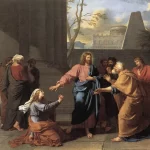
Augsburger Wunderzeichenbuch , folio 185, Revelation 11:5-8, circa 1552
(German inscription; transl.):
“And if anyone would harm them, fire pours from their mouth and consumes their foes. If anyone would harm them, this is how he is doomed to be killed… And when they have finished their testimony, the beast that rises from the bottomless pit will make war on them and conquer them and kill them, and their dead bodies will lie in the street of the great city.”
The identity of the two witnesses described in Revelation 11 has been a subject of much debate among theologians and Bible scholars. One prevalent modern interpretation suggests that these witnesses are Enoch and Elijah, based on the fact that neither experienced physical death. However, a closer examination of scriptural context and historical tradition offers a compelling argument for identifying the two witnesses as the Apostles Peter and Paul. This article aims to refute the modern doctrine that the two witnesses are Enoch and Elijah and to support the view that Revelation 11 prophetically recounts the ministries of Peter and Paul.
The Modern Doctrine: Enoch and Elijah
The Ascension of Enoch and Elijah
The belief that Enoch and Elijah are the two witnesses is primarily based on the notion that both ascended to heaven without dying. This interpretation arises from Genesis 5:24 regarding Enoch and 2 Kings 2:11 concerning Elijah. However, a critical examination of these texts and their contexts raises significant questions.
Enoch’s “Translation”
Genesis 5:24 states, “And Enoch walked with God: and he was not; for God took him.” This phrase has been interpreted to mean that Enoch was taken to heaven without experiencing death. However, the New Testament provides further insight. Hebrews 11:5 notes, “By faith Enoch was translated that he should not see death; and was not found, because God had translated him: for before his translation he had this testimony, that he pleased God.” The term “translated” (Greek: metatithemi) suggests a change of state rather than a physical ascension to heaven. It indicates that Enoch did not experience death in the usual manner but was taken by God in a special way, potentially passing from this life into eternal life without the normal process of death and burial.
Elijah’s Whirlwind
2 Kings 2:11 describes Elijah being taken up by a whirlwind into heaven. This account has led to the belief that Elijah was taken bodily to heaven. However, the term “heaven” (Hebrew: shamayim) can refer to the sky or the atmospheric heavens rather than the dwelling place of God. This interpretation is supported by the account in 2 Chronicles 21:12-15, where Elijah sends a letter to King Jehoram, indicating that he was still on earth after his supposed ascension.
Jesus’ Testimony
In John 3:13, Jesus states, “And no man hath ascended up to heaven, but he that came down from heaven, even the Son of man which is in heaven.” This clear declaration by Jesus challenges the notion that Enoch and Elijah physically ascended to the abode of God. It emphasizes that only Jesus, who descended from heaven, has the authority to ascend to heaven.

York Minster, Great East Window – Coventry glazier John Thornton
circa 1405 and 1408
The Traditional View: Peter and Paul
The Ministries of Peter and Paul
The identification of the two witnesses as Peter and Paul aligns with the broader narrative of the New Testament and the early Christian church. Peter and Paul were pivotal figures in the spread of Christianity, representing the Jewish and Gentile branches of the faith, respectively.
The Two Olive Trees and Lampstands
Revelation 11:4 describes the two witnesses as “the two olive trees, and the two candlesticks standing before the God of the earth.” This imagery is reminiscent of Zechariah 4, where the olive trees represent anointed ones who serve the Lord. In the context of the early church, Peter and Paul embody this symbolism through their leadership and evangelistic efforts.
The Witnesses’ Miraculous Powers
Revelation 11:5-6 attributes miraculous powers to the two witnesses, such as fire proceeding from their mouths, shutting heaven so that it does not rain, and turning waters into blood. The ministries of Peter and Paul were marked by similar signs and wonders. Peter’s encounters with divine power include the healing of the lame man at the temple (Acts 3:1-10) and the raising of Tabitha from the dead (Acts 9:36-42). Paul performed numerous miracles, such as striking Elymas the sorcerer with blindness (Acts 13:6-11) and healing a crippled man in Lystra (Acts 14:8-10).
Martyrdom and Witness
The culmination of Peter and Paul’s ministries was their martyrdom in Rome under Nero. Their deaths align with the fate of the two witnesses in Revelation 11:7-10, who are killed by the beast from the abyss and whose bodies lie in the street of the great city. The early Christian tradition, supported by historical records, attests to the martyrdom of both apostles in Rome, highlighting their role as witnesses unto death.
Scriptural and Historical Evidence

Apocalypse with commentaries by Andrew of Caesarea This manuscript was made around 1800 by the “Old Believers,” a group of Russian Christians who dissented from the Russian Orthodox Church and were subsequently persecuted and excommunicated.
– Walters Ms. W917 –
Circa 1800
The Context of Revelation
Revelation 11 must be understood within the broader context of the book’s apocalyptic genre and symbolic language. The imagery and symbolism often draw from Old Testament references and the experiences of the early church. The depiction of the two witnesses reflects the historical realities and theological themes of the apostolic age.
The Role of Peter and Paul
Peter and Paul’s roles in the early church and their significant contributions to its expansion make them fitting candidates for the two witnesses. Peter, as the apostle to the Jews, and Paul, as the apostle to the Gentiles, represent the unity and diversity of the early Christian movement. Their combined ministries encompass the prophetic and apostolic witness that Revelation 11 seeks to convey.
Addressing Counterarguments
The Popularity of the Enoch and Elijah View
The idea that Enoch and Elijah are the two witnesses persists due to their unique departures from earthly life and their prophetic significance. However, this view overlooks the broader scriptural narrative and the specific details provided in Revelation 11. The modern interpretation often relies on extrabiblical traditions and assumptions rather than a thorough exegesis of the biblical text.
The Role of Tradition and Interpretation
While tradition plays a significant role in shaping theological perspectives, it is essential to critically evaluate these traditions in light of scriptural evidence. The early church’s understanding of Peter and Paul’s ministries, coupled with the symbolic language of Revelation, provides a robust foundation for identifying them as the two witnesses.
Embracing the Apostolic Witness
The identification of the two witnesses in Revelation 11 as Enoch and Elijah is a modern doctrine that, upon closer examination, lacks substantial scriptural support. Instead, the traditional view that these witnesses represent the apostles Peter and Paul offers a more coherent and contextually grounded interpretation. By recognizing the ministries, miracles, and martyrdoms of Peter and Paul, we can appreciate the prophetic significance of their witness and the enduring impact of their testimony on the early Christian church.
As we study the book of Revelation and its rich symbolism, let us be mindful of the broader narrative of Scripture and the historical realities of the early church. In doing so, we honor the legacy of the apostles and their unwavering commitment to proclaiming the gospel of Jesus Christ.









